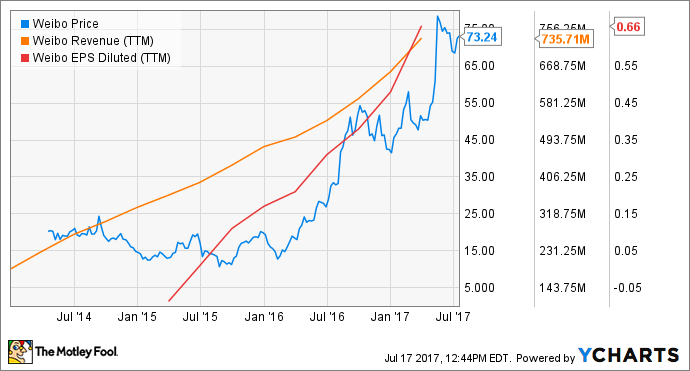Chinese social media company Weibo (WB 2.38%) has built an impressive audience, recording 340 million monthly active users (MAUs) as of March 30 and showing signs that it could continue to deliver impressive growth.
Last quarter saw Weibo grow revenue 67% year over year and increase its earnings a whopping 561% -- levels that should pique the interest of investors on the hunt for growth stocks. Let's dive into the company's history to get a better idea of where its been and where it might be heading.

Image source: Getty Images.
The early days
Weibo was started as a division of Chinese telecom Sina (SINA) in Aug. 2009, and it quickly attracted a large user base as a result of a vacuum that was created when China banned social media sites, including Facebook and Twitter. Sina designed its microblogging platform to be a close copy of Twitter; however, it also introduced features that would later be adopted by the platform that served as its inspiration.
Tighter censorship and regulation didn't stop Sina Weibo from rapidly building an audience. While discussions of politics still took place, the company was largely successful in steering conversations away from controversial topics and creating a culture for its platform that revolved around social and entertainment content. Sina realized early on that having celebrities on Weibo would be a substantial draw and reached out to big names with the promise of free publicity and promotional opportunities. Being able to interact and keep up with celebrities helped bring users in and added to the network effect that helped Weibo beat out competing microblogging platforms.
By 2013, Weibo had roughly 500 million registered accounts, but many of these accounts were bots (or "zombies" as they're called in China) rather than actual people, and Sina's microblog platform was entering a period that saw its outlook worsen. Some studies suggested that Weibo's active users and engagement declined significantly from 2012 to 2013, citing competition from Tencent's WeChat messaging service, government censorship, and a deteriorating user experience as reasons for the sudden onset of headwinds. But the reported declines in the user base were largely the result of Sina removing bot accounts from the microblog platform, and the company reported that the platform's daily active user base continued to climb.
IPO, policy change, share price explosion
In April 2014, Weibo split from Sina with an initial public offering at $17 per share, valuing the company at roughly $3.5 billion. Shares closed up 19% at the end of the company's first day on the market. CEO Charles Chao later stated that the company made the mistake of pricing shares too low. Prior to Weibo's IPO, Alibaba made a $586 million investment in the offshoot messaging platform, and it remains a key partner for the company. Today, Sina retains a 46% stake in Weibo, while Alibaba reportedly owns 31.5% of the company.
In 2015, Weibo implemented a change at the behest of the Chinese government that required users to register with their real name and national identification number. Softer versions of this policy had been tried before, but the move marked a shift toward a stricter implementation. The new policy prompted speculation that users would abandon public microblogging in favor of Tencent's more private WeChat messaging platform. But time would show that the two platforms were different enough to coexist and that real-name registration didn't keep Weibo from posting fantastic user growth. Moreover, having real names attached to accounts likely had a beneficial impact on the company's advertising business.
Weibo's user base continued to expand as a result of mobile growth and an increase in Chinese internet connectivity, and the company was able to generate substantially more revenue per user.
Data by YCharts.
In an effort to build new revenue streams, Weibo made a big push to compete with Tencent's WeChat in the online payment space. Both companies attracted media attention in 2015 for giving users digital currency to celebrate the Chinese New Year and get new people on board their respective platforms. Ultimately, WeChat's payment service emerged as the dominant offering.
While the push into online payment services hasn't worked out for Weibo, the company has seen stellar growth in video and live streaming. The company invested in video streaming company Yixia in 2015, and a year later introduced its own live streaming function as a native feature of the Weibo app -- which was quickly adopted by the service's user base and is now central to the company's future.
What's next for Weibo
Weibo is counting on video streaming among users and its own push into featured video content, including variety shows and sports broadcasts, to fuel the next leg of its growth story. However, this plan recently encountered an unexpected roadblock. In June, the Chinese government demanded a shutdown of Weibo's video and audio streaming features on the grounds that the company didn't have the proper license for the feature and because it needed to implement more restrictive guidelines and moderation for political content.
While this presents a significant threat to the company's growth trajectory, it appears likely that Weibo will be able to reinstate streaming features after it files for the necessary license -- as Alibaba was able to resolve a similar situation by acquiring government certification. Advertising has been, and will likely remain, the major source of Weibo's revenues, and with Chinese ad spending migrating to streaming video content, it's crucial that the company quickly reenter the space.






